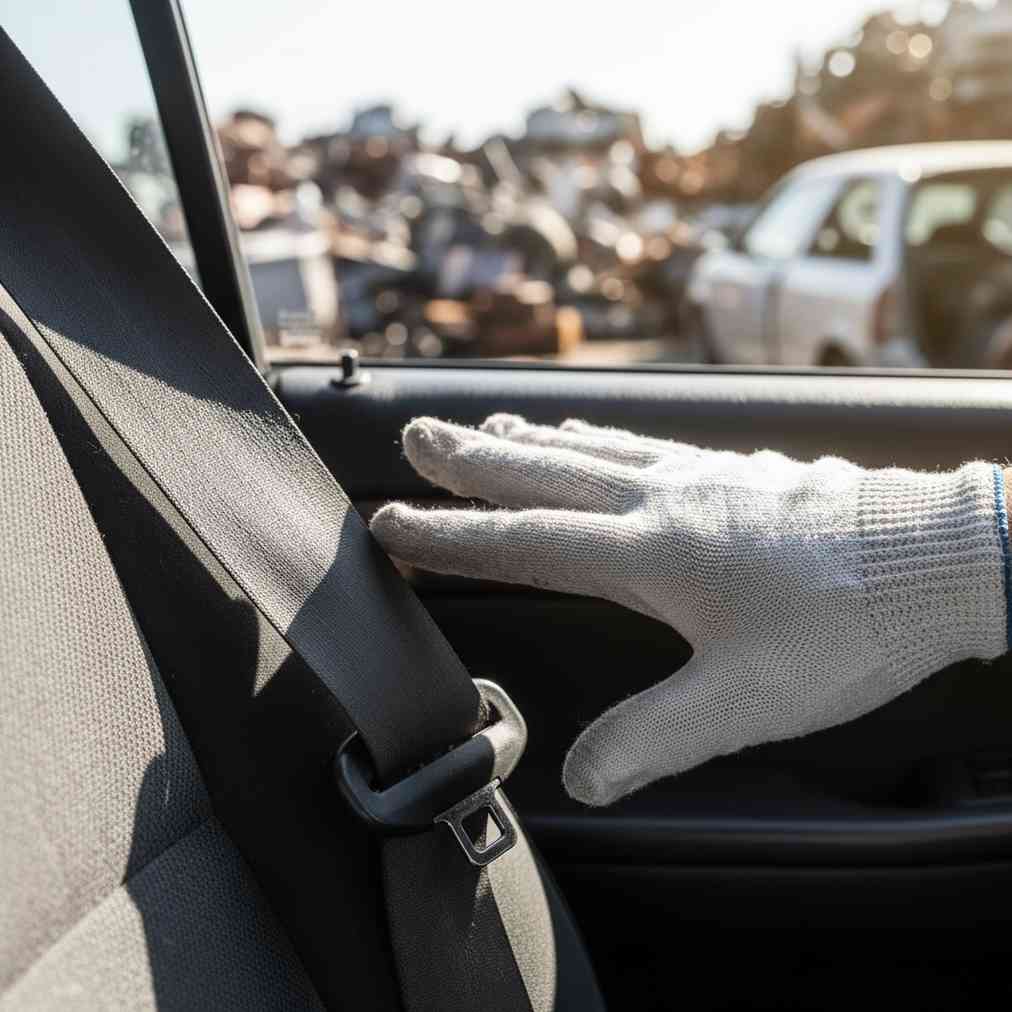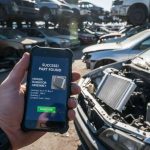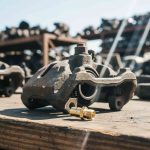Understanding Seatbelt Safety and the Critical Role of Inspection
Seatbelts are among the most critical safety components in any vehicle, designed to protect occupants during collisions by restraining them and preventing severe injuries or fatalities. According to the National Highway Traffic Safety Administration (NHTSA), seatbelts reduce the risk of death for front-seat passengers by 45% and serious injury by 50%. In 2021, seatbelts saved an estimated 14,955 lives in the United States alone.
Despite these compelling statistics, a significant number of fatalities in 2022 involved passengers not wearing seatbelts, with 44% of vehicle passengers killed in accidents being unrestrained. This underscores the paramount importance of ensuring your seatbelt system is in optimal working condition at all times.
Locating Seatbelt Assemblies in Donor Vehicles
When searching for a used seatbelt assembly at local auto salvage yards, understanding the typical location and mounting configuration is essential. Seatbelt assemblies are typically found in specific areas of the vehicle’s structure:
- B-pillar location: The retractor mechanism is usually mounted behind the B-pillar trim (the pillar between front and rear doors)
- Floor anchor points: The buckle assembly and lower anchor points are secured to the vehicle floor or seat frame
- Upper shoulder anchor: Located on the upper portion of the B-pillar or door frame
- Pretensioner components: Often integrated with the retractor mechanism or buckle assembly
Before beginning any removal process, it’s crucial to understand that buying used auto parts requires careful consideration, especially for safety-critical components like seatbelts.
Comprehensive Inspection Checklist for Used Seatbelts
Unlike other used auto parts that can be visually inspected for basic functionality, seatbelts require meticulous evaluation due to their life-saving role. The California BAR Vehicle Safety Systems Inspection Manual provides detailed guidelines for proper seatbelt inspection.
Visual Inspection of Webbing Material
The seatbelt webbing is the primary load-bearing component and requires thorough examination:
- Fraying or cuts: Look for any loose threads, cuts, or worn edges along the entire length
- Discoloration: Fading from sunlight exposure can indicate material degradation
- Burn marks: Any heat damage compromises webbing strength
- Stitching integrity: Check for loose or broken stitching at connection points
- Thickness consistency: Feel for any thin spots or areas where the webbing feels different
“Even minor damage can significantly reduce the belt’s strength. Sunlight exposure can also degrade webbing, so look for fading patterns that indicate prolonged UV exposure.” – Safety Restore Blog
Buckle and Latch Plate Functionality
| Component | What to Check | Red Flags |
|---|---|---|
| Buckle Housing | Cracks, deformation, smooth operation | Visible cracks, loose components, corrosion |
| Latch Plate | Secure clicking, easy release | Difficult insertion, weak click, sticking |
| Release Button | Smooth operation, immediate release | Excessive force required, delayed release |
Retractor Mechanism Testing
The MyAirbags step-by-step testing guide emphasizes the importance of thorough retractor testing:
- Smooth extension: Pull the webbing fully out – it should extend without binding or catching
- Consistent retraction: Allow the belt to retract completely without slack or hesitation
- Emergency locking: Perform a sudden jerk test to ensure the mechanism locks immediately
- Angle sensitivity: Test locking when the retractor is tilted at various angles
If any of these tests fail, the retractor mechanism is compromised and should not be used, as it may fail during a collision when proper restraint is critical.
Tools and Preparation for Seatbelt Removal
Proper preparation and the right tools are essential for safely removing a seatbelt assembly without damaging the component or the donor vehicle. Having the right equipment is similar to what you’d need when mechanics recommend for junkyard visits.
Essential Tools Checklist
- Socket set: Common sizes include T50 Torx, 17mm, 10mm, 16mm, and 5/8 inch
- Screwdrivers: Both Phillips and flathead varieties
- Trim removal tools: Plastic pry tools to avoid damage to interior panels
- Ratchet and extensions: For accessing bolts in tight spaces
- Work gloves: Protection and improved grip
- Flashlight or headlamp: Adequate lighting for inspection and removal
Safety Preparations
Before beginning any removal process, especially in vehicles with pretensioner systems, safety preparations are crucial:
- Battery disconnection: Disconnect the negative terminal and wait 3-5 minutes
- Airbag precautions: Be aware of potential airbag deployment risks
- Vehicle history verification: Ensure the donor vehicle wasn’t involved in accidents
- Documentation: Take photos of the assembly before removal for reference
Step-by-Step Removal Process
The removal process varies between vehicle makes and models, but the general procedure follows a consistent pattern. This process is more complex than removing other components like used car doors due to safety considerations.
Interior Trim Removal
Access to seatbelt mounting points typically requires removing interior trim pieces:
- Door sill plates: Remove plastic covers over lower mounting points
- B-pillar trim: Carefully pry off upper and lower pillar covers
- Seat components: May need to move or remove seats for full access
- Floor carpeting: Fold back carpet to access floor anchor points
Identifying and Removing Mounting Hardware
| Component | Typical Location | Common Hardware |
|---|---|---|
| Retractor Assembly | B-pillar interior | 2-3 bolts, usually T50 or 17mm |
| Floor Anchor | Vehicle floor/seat frame | Single bolt, often 16mm or 5/8″ |
| Upper Anchor | Upper B-pillar | Single bolt, T50 or 17mm typical |
| Buckle Assembly | Seat or floor mounted | 1-2 bolts, varies by vehicle |
Electrical Component Disconnection
Modern seatbelt assemblies often include electrical components that must be properly disconnected:
- Pretensioner connectors: Usually yellow connectors with safety clips
- Buckle sensors: Small connectors for occupancy detection
- Warning system wires: Connected to dashboard warning lights
The SCRS YouTube channel provides excellent visual guidance for handling these electrical components safely.
Critical Safety Considerations and Risk Assessment
While crash repair using junkyard parts can be cost-effective for body components, seatbelts present unique safety challenges that require careful consideration.
Hidden Damage Assessment
Unlike visible damage, internal component stress and fatigue may not be detectable through standard inspection methods:
- Stress testing limitations: Home inspection cannot replicate crash-force testing
- Material fatigue: Repeated use may weaken webbing fibers invisibly
- Component aging: Springs and mechanisms may lose effectiveness over time
- Previous deployment: Pretensioners may have deployed without visible evidence
Legal and Insurance Implications
Using non-certified safety components can have serious legal and insurance consequences:
| Risk Category | Potential Consequences | Mitigation Strategies |
|---|---|---|
| Legal Liability | Personal injury lawsuits, criminal charges | Use only certified components |
| Insurance Claims | Denied claims, policy cancellation | Document all repairs with receipts |
| Vehicle Inspection | Failed safety inspections | Ensure compliance with local regulations |
| Resale Value | Reduced value, disclosure requirements | Maintain repair documentation |
The California Vehicle Code equipment requirements specify that all safety equipment must meet original manufacturer specifications.
Alternative Solutions: Professional Repair vs. New Replacement
Given the risks associated with used seatbelt assemblies, exploring alternative solutions often provides better value and safety assurance. Just as you might consider OEM car parts for quality assurance, seatbelt safety deserves similar consideration.
Professional Seatbelt Repair Services
Specialized repair services can restore seatbelts to OEM standards while providing warranties and certification:
- Webbing replacement: New webbing installed on existing retractor mechanisms
- Pretensioner rebuilding: Professional restoration of deployment mechanisms
- Buckle refurbishment: Internal mechanism cleaning and part replacement
- Testing certification: Professional testing to OEM specifications
- Warranty coverage: Often includes lifetime warranties on repairs
Cost-Benefit Analysis
| Option | Typical Cost | Safety Rating | Warranty |
|---|---|---|---|
| Used Assembly | $50-150 | Unknown/Risky | None |
| Professional Repair | $150-300 | OEM Standard | Lifetime typical |
| New OEM | $300-800 | Factory Standard | Manufacturer warranty |
| New Aftermarket | $200-400 | Varies | Limited warranty |
Vehicle-Specific Considerations
Different vehicle makes and models have unique seatbelt configurations that affect the removal and replacement process. Understanding these differences is crucial for successful removal and future installation.
Common Vehicle Variations
- European vehicles: Often use different mounting hardware and torque specifications
- Luxury vehicles: May include additional sensors and electrical components
- Older vehicles: Simpler systems but may lack modern safety features
- Trucks and SUVs: Heavy-duty mounting systems with higher torque requirements
When working with specific makes like Toyota Camry parts or Honda Accord parts, manufacturer-specific service manuals provide detailed removal procedures.
Age and Technology Considerations
The age of the vehicle significantly impacts seatbelt technology and removal complexity:
| Era | Technology | Removal Complexity |
|---|---|---|
| Pre-1990 | Basic 3-point systems | Simple – mostly mechanical |
| 1990-2000 | Basic pretensioners | Moderate – some electrical |
| 2000-2010 | Advanced pretensioners, sensors | Complex – multiple systems |
| 2010+ | Smart systems, multiple airbags | Very complex – integrated systems |
Installation and Testing After Removal
If you decide to proceed with a used seatbelt assembly after thorough inspection, proper installation and testing are critical for safety. The installation process requires the same attention to detail as the removal process.
Proper Installation Procedures
- Torque specifications: All mounting bolts must be tightened to manufacturer specifications
- Electrical connections: Ensure all connectors are properly seated and secured
- Routing verification: Webbing must follow original routing paths without twists
- Clearance check: Ensure no interference with seat movement or other components
The Ford Owner Manual provides detailed torque specifications and installation procedures for Ford vehicles.
Post-Installation Testing Protocol
After installation, comprehensive testing ensures the seatbelt functions properly:
- Function test: Test extension, retraction, and locking mechanisms
- Electrical test: Verify warning lights and sensors function correctly
- Load test: Apply moderate force to test mounting security
- Integration test: Ensure compatibility with airbag and vehicle systems
Professional testing equipment can verify that the seatbelt meets safety standards, similar to how safety inspections and calibration procedures ensure other safety systems function correctly.
Environmental and Regulatory Compliance
Seatbelt assemblies must meet various regulatory standards and environmental requirements that affect their use and disposal.
Federal Motor Vehicle Safety Standards (FMVSS)
The California BAR safety systems regulations enforce federal standards that require:
- FMVSS 208: Occupant crash protection standards
- FMVSS 209: Seat belt assembly requirements
- FMVSS 210: Seat belt assembly anchorages
- Testing compliance: All components must pass standardized testing
State-Specific Requirements
Different states have varying requirements for safety equipment modifications and inspections:
| State Category | Inspection Requirements | Compliance Standards |
|---|---|---|
| Strict Inspection States | Annual safety inspections | Full FMVSS compliance required |
| Moderate States | Bi-annual or registration-based | Basic functionality required |
| No Inspection States | Owner responsibility | Federal standards still apply |
Final Recommendations and Expert Opinions
Based on comprehensive research and expert opinions from safety professionals, the consensus strongly favors avoiding used seatbelt assemblies for safety-critical applications. While the process of finding and removing these components is technically possible, the risks often outweigh the potential cost savings.
“For vehicle owners needing seat belt replacement, the safest and most cost-effective long-term approach involves purchasing new, certified components from reputable manufacturers or authorized dealers.” – Safety Restore Technical Team
When Used Seatbelts Might Be Acceptable
Limited scenarios where used seatbelt assemblies might be considered include:
- Show vehicles: Non-driving display vehicles where safety isn’t a concern
- Parts donors: Harvesting specific components like buckles for repair purposes
- Research purposes: Technical study or reverse engineering applications
- Temporary solutions: Only with professional inspection and immediate replacement planning
Best Practices Summary
If you must work with used seatbelt assemblies, follow these critical guidelines:
- Complete documentation: Record all inspection findings and test results
- Professional consultation: Have a certified technician review your assessment
- Limited use duration: Consider used assemblies as temporary solutions only
- Regular re-inspection: Monitor condition more frequently than new components
- Replacement planning: Budget for new or professionally repaired replacements
Remember that seatbelts are not typical high-value used auto parts where cost savings justify the risks. The potential consequences of seatbelt failure far exceed any financial benefits of using salvaged components.
For those interested in learning more about automotive safety and finding quality parts, explore other resources like our comprehensive automotive blog for additional guidance on vehicle maintenance and safety.





Leave a Reply
You must be logged in to post a comment.